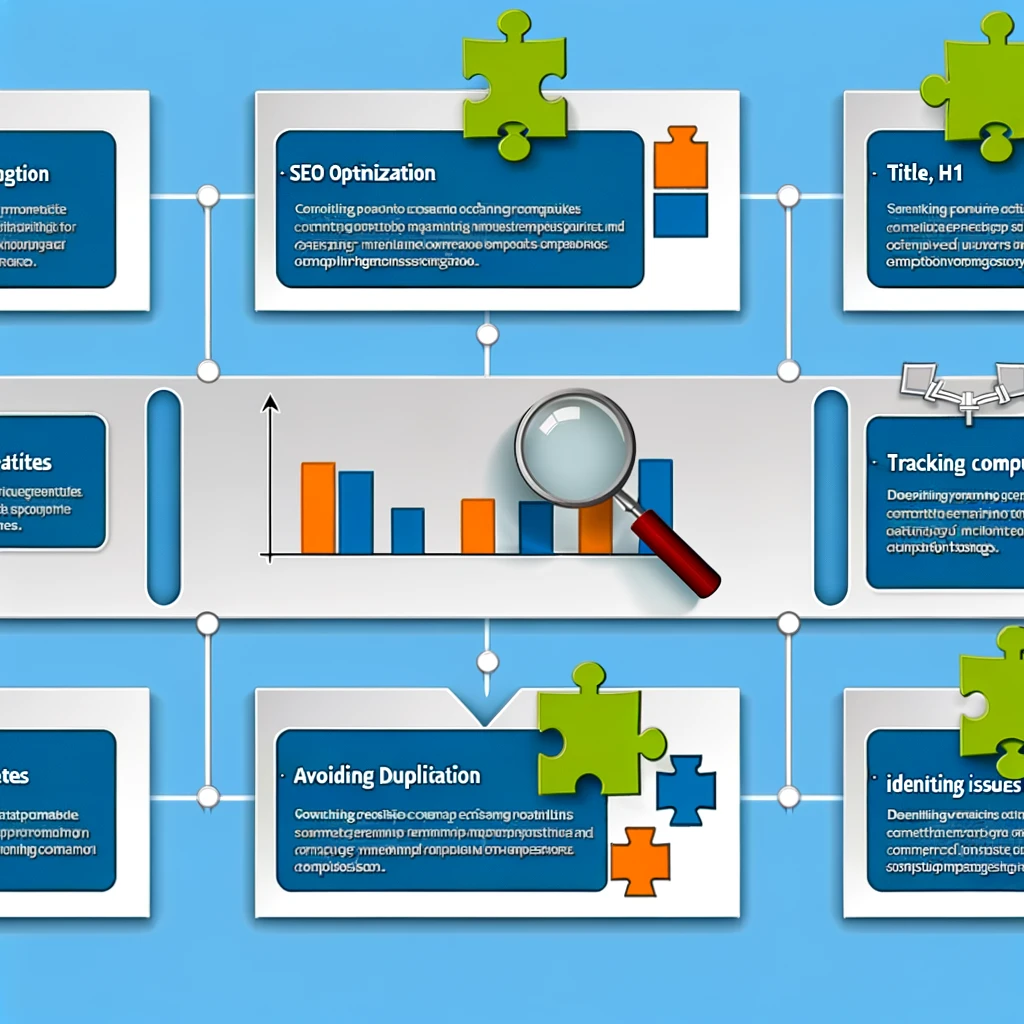
Why is it important to monitor title, h1, and description changes?
Monitoring changes in title, h1, and description tags is important for several reasons:
SEO Optimization:
These elements are crucial for search engine optimization (SEO). Changes in these tags can significantly impact a website's search engine rankings. By monitoring these changes, you can ensure that your website remains optimized for relevant keywords and phrases.
SEO Optimization is a crucial aspect of digital marketing that involves enhancing a website's visibility and ranking on search engine results pages (SERPs). Monitoring changes in title, h1, and description tags plays a significant role in SEO Optimization for several reasons:
-
Keyword Optimization: Title and h1 tags are primary elements that search engines use to understand the content of a webpage. By including relevant keywords in these tags, you can improve the page's ranking for those keywords. Monitoring changes ensures that your pages are always optimized for the most effective keywords based on current trends and search patterns.
-
Click-Through Rate (CTR): The title tag and meta description are often displayed in the SERPs as the clickable headline and summary of the page, respectively. Well-crafted titles and descriptions can increase the CTR, driving more organic traffic to your website. Monitoring these tags allows you to test and refine them to maximize CTR.
-
Content Relevance: Search engines prioritize content that is relevant to the user's query. By monitoring and updating your title, h1, and description tags to align with the content of your pages, you can signal to search engines that your content is relevant and valuable, potentially boosting your rankings.
-
User Experience: Clear and descriptive titles and headings contribute to a better user experience by helping visitors understand what your page is about quickly. This can lead to longer dwell times and lower bounce rates, which are positive signals for search engines.
-
Adapting to Algorithm Changes: Search engine algorithms are constantly evolving. By monitoring your tags, you can adapt to these changes and ensure that your website remains compliant with the latest SEO best practices.
-
Structured Data: Monitoring changes also allows you to integrate structured data (schema markup) into your title and h1 tags when appropriate. This can enhance your visibility in SERPs through rich snippets, further improving your SEO performance.
In summary, monitoring changes in title, h1, and description tags is a critical component of SEO Optimization. It helps ensure that your website is continually optimized for search engines, improving your visibility, driving organic traffic, and enhancing the overall user experience.
Consistency and Relevance:
Regular monitoring helps maintain consistency and relevance in your website's content. It ensures that your titles and descriptions accurately reflect the content of your pages, which is important for both user experience and SEO.
Consistency and relevance are key factors in maintaining a high-quality website that meets user expectations and performs well in search engine rankings. Monitoring changes in title, h1, and description tags is important for ensuring consistency and relevance for several reasons:
-
Brand Consistency: Consistent use of language, tone, and messaging in your title and description tags reinforces your brand identity and helps build trust with your audience. Monitoring these tags ensures that any changes align with your brand's voice and messaging strategy.
-
Content Alignment: The title and h1 tags should accurately reflect the content of the page. Monitoring these tags ensures that they remain relevant and aligned with the page content, providing a clear and accurate representation of what users can expect to find on the page.
-
User Expectations: Users rely on titles and descriptions to decide whether to click on a link in the search results. Consistent and relevant tags ensure that users have a clear understanding of what the page is about, leading to a better user experience and potentially higher click-through rates.
-
Avoiding Misleading Content: Monitoring changes helps prevent the use of misleading or clickbait titles and descriptions that don't accurately represent the page content. This is important for maintaining credibility with your audience and avoiding penalties from search engines.
-
Content Updates: As your website's content evolves, it's important to update your title and h1 tags to reflect any changes. Regular monitoring ensures that these tags remain relevant and up-to-date, enhancing the overall user experience.
-
Navigational Consistency: Consistent titles and headings across your website help users navigate and understand the structure of your content. Monitoring changes in these tags can ensure that your site's navigation remains intuitive and user-friendly.
In summary, monitoring changes in title, h1, and description tags is essential for maintaining consistency and relevance on your website. It ensures that your tags accurately reflect your brand, align with your content, meet user expectations, and contribute to a positive and cohesive user experience.
Tracking Competitors:
Monitoring changes in these tags can also provide insights into your competitors' SEO strategies. By observing their changes, you can understand their focus areas and adjust your strategy accordingly.
Tracking competitors is an essential aspect of maintaining a competitive edge in the digital landscape. Monitoring changes in their title, h1, and description tags can provide valuable insights for several reasons:
-
Keyword Strategy: By observing changes in your competitors' title and h1 tags, you can gain insights into their keyword targeting strategies. This can help you identify new keywords to target or adjust your existing keyword strategy to stay competitive.
-
Content Trends: Monitoring your competitors' tags can reveal trends in content topics and themes. If you notice multiple competitors updating their tags to focus on a particular topic, it might indicate a growing interest in that area, signaling an opportunity for you to create or update content accordingly.
-
SEO Tactics: Changes in competitors' title and description tags can also indicate shifts in their SEO tactics. For example, if they start using more long-tail keywords or question-based phrases, it might suggest a focus on voice search optimization or featured snippets.
-
Messaging and Positioning: By analyzing competitors' tags, you can understand how they position themselves and their products or services. This can help you refine your messaging to differentiate your offerings and appeal to your target audience.
-
Performance Benchmarking: Monitoring changes in competitors' tags, along with their search engine rankings, can help you benchmark your performance. If a competitor's rankings improve following changes to their tags, it might indicate effective optimizations that you could consider for your own website.
-
Market Insights: Regularly tracking competitors' tags can provide broader insights into market trends and shifts in consumer interests. This can inform your content strategy and ensure that your website remains relevant and appealing to your target audience.
In summary, monitoring changes in competitors' title, h1, and description tags is a valuable practice for staying informed about their strategies, identifying opportunities for differentiation, and keeping up with market trends. It can inform your own SEO and content strategies, helping you maintain a competitive edge in the digital landscape.
Avoiding Duplication:
Keeping an eye on title and description tags helps avoid duplication, which can negatively affect your website's SEO performance. Search engines might penalize websites with duplicate content, so it's important to ensure each page has unique tags.
Avoiding duplication is crucial for maintaining the uniqueness and integrity of your website's content. Monitoring changes in title, h1, and description tags plays a significant role in preventing duplication for several reasons:
-
Unique Titles and Descriptions: Search engines prefer unique content, including title and description tags. By monitoring these tags, you can ensure that each page on your website has distinct and specific tags, reducing the risk of being penalized for duplicate content.
-
Improved Indexing: Unique title and h1 tags help search engines understand the structure and content of your website. This can improve the indexing of your pages, making it easier for search engines to crawl and categorize your content.
-
Better User Experience: Avoiding duplication in titles and headings can enhance the user experience by providing clear and distinct navigation cues. Users are less likely to encounter confusingly similar content, which can improve their overall satisfaction and engagement with your site.
-
Increased Click-Through Rates: Unique and descriptive title and description tags can lead to higher click-through rates (CTRs) from search engine results pages (SERPs). If each page has a distinct title and description, users are more likely to find the content they are searching for, resulting in more clicks and traffic to your site.
-
Content Differentiation: Monitoring and avoiding duplication in your tags can help differentiate your content from that of your competitors. This can increase the perceived value of your content and improve its ranking potential in search engine results.
-
Avoiding Content Cannibalization: By ensuring that your title and h1 tags are unique, you can avoid content cannibalization, where multiple pages on your website compete for the same keywords. This can dilute the effectiveness of your SEO efforts and reduce the visibility of your pages in search results.
In summary, monitoring changes in title, h1, and description tags to avoid duplication is essential for SEO success. It helps ensure that your content is unique, well-indexed, and provides a positive user experience, all of which contribute to better search engine rankings and increased website traffic.
Identifying Issues:
Regular monitoring can help identify any issues or errors in your tags, such as missing tags, incorrect keyword usage, or tags that are too long or too short. Addressing these issues promptly can improve your website's SEO performance.
Identifying and resolving issues in title, h1, and description tags is crucial for maintaining the health and performance of your website. Monitoring changes in these tags can help identify potential problems for several reasons:
-
Missing Tags: Regular monitoring can help you quickly identify pages that are missing title or h1 tags, which are essential for SEO. Missing tags can negatively impact your search engine rankings, so it's important to address these issues promptly.
-
Incorrect Keyword Usage: Monitoring changes in your tags can reveal instances of incorrect keyword usage, such as targeting irrelevant keywords or overstuffing keywords. This can harm your SEO efforts, so identifying and correcting these issues is crucial.
-
Tag Length Issues: Search engines have specific length recommendations for title and description tags. Monitoring can help you identify tags that are too long or too short, allowing you to adjust them to meet best practices and improve your search engine visibility.
-
Duplicate Content: Monitoring changes in your tags can help you identify duplicate content issues within your website. Duplicate tags can lead to confusion for search engines and users, so it's important to ensure that each page has unique and descriptive tags.
-
Broken Links: Changes in your tags might also indicate broken links or redirects, especially if you're updating URLs. Identifying and fixing broken links is essential for maintaining a good user experience and ensuring that search engines can properly crawl and index your pages.
-
Compliance with Guidelines: Monitoring your tags can help ensure that they comply with search engine guidelines. Non-compliance, such as using misleading or clickbait titles, can result in penalties and negatively impact your search engine rankings.
-
Alignment with Content Updates: As you update your website's content, it's important to ensure that your title and h1 tags remain relevant and aligned with the new content. Monitoring changes can help you identify discrepancies and make necessary adjustments.
In summary, monitoring changes in title, h1, and description tags is essential for identifying and addressing issues that can impact your website's SEO performance. By addressing these issues promptly, you can maintain the health of your website, improve your search engine rankings, and provide a better experience for your users.
Is essential for maintaining and improving your website's SEO, ensuring content relevance and consistency, staying competitive, avoiding duplication, and identifying and resolving issues.

See also:
Meta changes monitoring meaning?
Why is it important to monitor response code status?
What are the risks of website migration and how to make the migration secure?